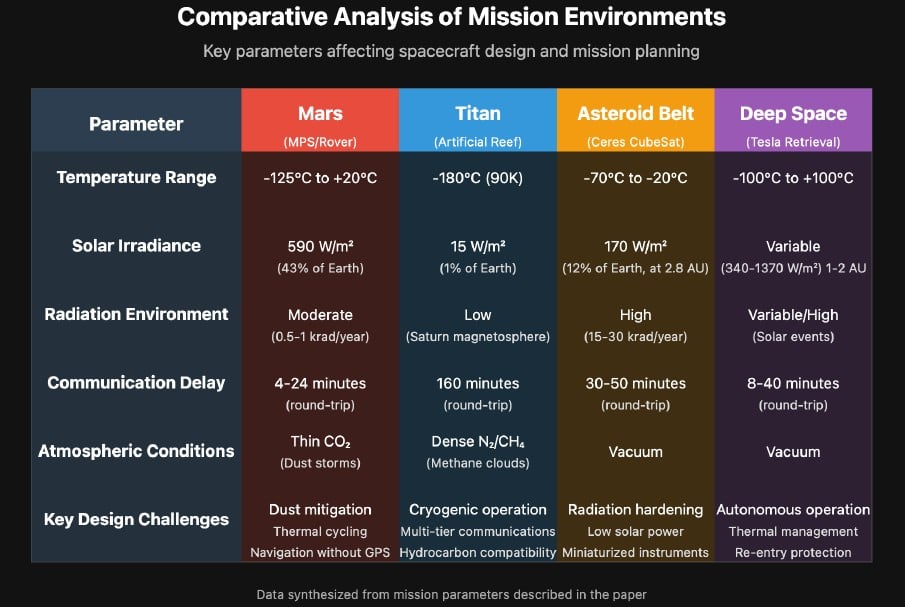There are plenty of engineering challenges facing space exploration missions, most of which are specific to their missions objectives. However, there are some that are more universal, especially regarding electronics. A new paper primarily written by a group of American students temporarily studying at Escuela Tecnica Superior de Ingenieria in Madrid, attempts to lay out plans to tackle several of those challenges for a variety of mission architectures.
The paper covers a wide range of topics, but it can fundamentally be broken down into four different “missions”, each of which have their own requirements. First is a Mars positioning system, similar to the Global Positioning System on Earth. Next is creating an artificial reef on Titan for the purposes of exploring the hydrocarbon oceans there for life. Then launching a CubeSat to Ceres, and finally collecting and returning to Earth the famous Tesla Roadster that was launched as part of a SpaceX marketing campaign.
Each of these missions has their own technical challenges, and each highlights one of the overarching challenges faced by all space exploration missions. The Mars Positioning System (MPS), for example, only has to deal with a “moderate” temperature range and has decent solar influx, but must also deal with dust and issues with thermal control. This system uses 24 orbiting satellites in 6 different orbital planes, combined with fancy atomic clocks and communications networks, to pinpoint a rover on the surface of Mars within 1m of its horizontal location and 2m of its vertical one. Dust is a particularly pervasive problem for any ground stations, as it can clog solar arrays limiting the power the system receives, which also varies widely based on the Martian seasons.
Fraser discusses why Titan is such an interesting missions target.
Titan also has seasons, though not as extreme as Mars’ – but it does get much colder on this moon of Saturn than it does on the closer-in red planet. The paper’s proposed mission to Titan takes the form of artificial reefs floating on the methane/ethane seas, which can reach temperatures of -180C. That extreme temperature would require specialized sensors, but the distance back to Earth requires an improved communication system that would involve using acoustic communication from the sensors back to the reefs, and then from the reefs up to an orbiting satellite, and thence back to Earth.
Communication with a stand-alone CubeSat is a little more straightforward, especially if it is closer – which is the plan for the CubeSat visiting Ceres, the “Queen of the Asteroid Belt”. Optimizing a CubeSats design for a good power/weight ratio is the focus of this mission, as it increases the throughput of the system’s communication channels which already suffer from a round-trip communications delay of up to 50 minutes. Other communications technologies, like data compression and long term secure storage onboard to ensure no data is dropped.
Collecting the Roadster seems an interesting choice of mission, but it would operate in some of the most challenging environments yet – deep space. High radiation levels and massive amounts of solar variability contribute to this difficulty, which the authors suggest could be overcome by making better use of AI. Some AI large language models have been adapted for use on spacecraft, such as Space Llama and the INDUS suite of LLMs, and which could someday soon help spacecraft operate with limited to no delayed input from human controllers back on Earth. Another challenge presented in returning the Roadster back to Earth is the heat shielding that would be required for reentry – this material would undergo the most dramatic temperature extremes of any others looked at in the paper.
Fraser discusses some of the intricacies of a Mars mission.
To prove out some of the ideas mentioned in the paper, the students modeled some of the frameworks for the Mars and Titan missions, and found that they were effective at solving the power and communication problems for those missions respectively. There’s a lot more work to go before any of these missions would see the light of day, but for the students who worked on them this paper was a great place to start.
Learn More:
J. de Curto et al – Advanced System Engineering Approaches to Emerging Challenges in Planetary and Deep-Space Exploration
UT – NASA’s Top 5 Technical Challenges Countdown: #4: Improved Navigation
UT – A Mission to Dive Titan’s Lakes – and Soar Between Them
UT – Astrophotographer Captures Musk’s Tesla Roadster Moving Through Space
